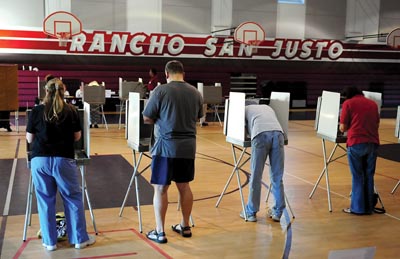With two extraordinarily important local items on the November ballot, it is crucial that voters get informed and do ample homework before making their decisions.
This isn’t your standard election – despite the disappointment of two councilmen, Ray Friend and Victor Gomez, running unopposed – because Hollister voters will be making two historic choices.
Do they want to extend the 1 percent sales tax to buoy a sinking budget – severely weighed down by the Great Recession but at least partially the fault of the same officials asking for a five-year renewal known as Measure E?
Second, and perhaps most important, who is going to become the first true mayor in Hollister’s 140-year history? Who will voters choose to take on the immense, and much needed, role of standing as the Leader-in-Chief for a city that sorely lacks leadership?
In a presidential election year, turnout will jump significantly – it was 82 percent in November 2008, compared with 62 percent in November 2010 – further heightening implications of the electorate’s cumulative knowledge.
As for the mayoral election, there are four candidates on the ballot: Doug Emerson, Marty Richman, Keith Snow and Ignacio Velazquez. They all bring widely varying backgrounds and agendas to the table.
Voters should study those backgrounds and research the candidates’ ideas for specific solutions to Hollister’s foremost problems: How are we planning to generate economic activity and how will city officials get control of the budget before snowballing deficits lead to bankruptcy?
With four candidates in the race, and the need for each to separate from the pack, they should be eager to offer detailed proposals for fixing the economy and budget. If they don’t offer specifics, voters should demand them.
This is far too important of an election for voters to waste any time on pie-in-the-sky candidates who merely talk in generalities and pose with their families on postcards rather than discuss the real issues.
As for Measure E, the extension to Measure T approved in 2007, voters will have the same opportunity to see and hear arguments for and against it. They will have the chance to inform themselves and filter out rhetoric meant to sidetrack their attention away from substance.
A pro-Measure E committee is established, includes four local residents, and will run the campaign focused on convincing residents the additional five-year investment is worth the $3 million or so it generates annually, funds intended to avoid a massive layoff in the next three years.
Unlike 2007, an official opposition group has formed and will make the argument that city leaders have demonstrated – through their mismanagement of the additional tax funds over the past five years – that we are better off with economic benefits resulting from a 1 percent reduction to the current 8.25 percent paid locally.
Both sides have valid arguments. Now, just as with the mayor’s race, it is up to voters to make informed decisions.









